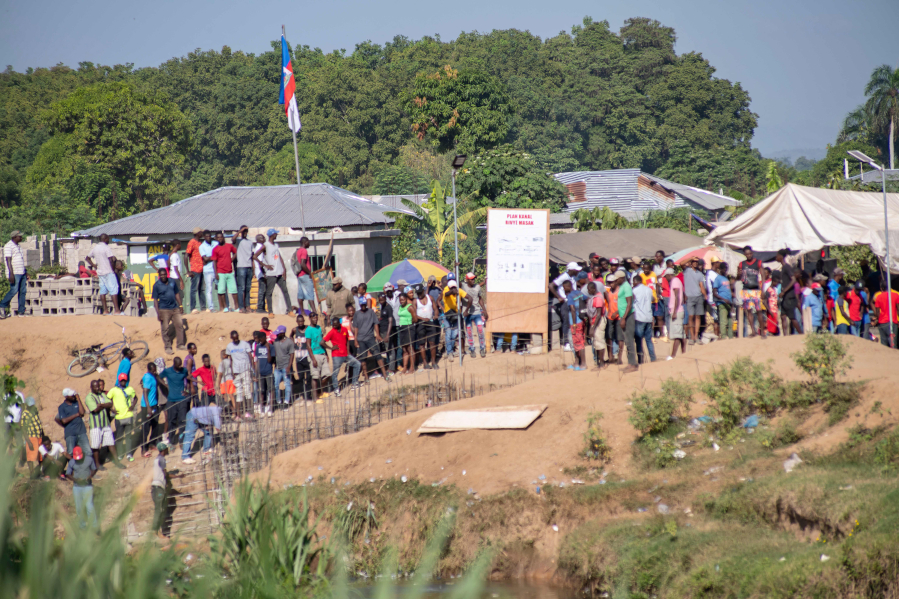An ongoing border dispute between Haiti and the Dominican Republic, which started over the construction of a canal on Haitian soil, grew more tense this week as each side accused the other of unlawfully entering its territory.
The latest border clash between the two acrimonious neighbors, which share the island of Hispaniola, unfolded in the vicinity of what’s known as Pyramid 13 on the border area that divides the Dominican Republic and Haiti near the Haitian city of Ounanaminthe. It is also where the Dominican Republic is building a wall inside its territory to keep undocumented Haitians out.
That wall, Dominican authorities admit, appears to have led to a confusion about where the Dominican Republic ends and where Haiti begins.
Even though the wall faces Haiti, both sides of the structure are actually within Dominican territory, the Dominican officials say, and their military has the right to patrol both sides of the wall. Some Haitians, however, claim that the area on the side of the wall facing Haiti is a no-man’s-land and that even if it isn’t, the Dominican Republic ceded its rights to that side once it built the wall. It’s unclear how far away from Haitian territory the wall is located, but the Dominican presidency’s office said that there are clear markers in the area indicating each country’s border.
Either way, the sudden appearance of Dominican soldiers crossing over the wall Monday led to Haitians protesting and burning tires.
Homero Figueroa, spokesman for Dominican President Luis Abinader, said the incidents occurred while the Dominican Army was carrying out its patrol of the area on Monday morning. A group of Haitian nationals entered Dominican territory to obstruct the patrol, he said.
“The action appears to be due to an apparent misunderstanding by Haitian citizens regarding the border limits that separate both countries,” he said in a statement.
In Haiti, media outlets and bloggers reported that Dominican soldiers had crossed over the wall and illegally entered Haitian territory. They accompanied their posts with videos and photos of the soldiers standing in front of the wall and Dominican military helicopters hovering overhead.
The erroneous reporting added to tensions along the border not far from the canal. Some Haitians severely beat the head of Haiti’s Protected Areas Surveillance Brigade, Samson Camiel, as he visited his staff in the area. Camiel was accused by the angry Haitian crowd of colluding with Dominican authorities and supporting their soldiers’ “intrusion” onto Haitian soil. Camiel was eventually rescued by Haitian police.
In Port-au-Prince, phone calls were exchanged between the Dominican ambassador, Prime Minister Ariel Henry and the foreign ministries of both countries in an effort to defuse the tensions, which have been simmering for nearly two months.
In statement late Wednesday, Haiti’s government said Foreign Affairs Minister Jean Victor Généus and Dominican Foreign Minister Roberto Alvarez have agreed to work to tamp down tensions while awaiting a solution.
“The Ministry of Foreign Affairs and Religious Affairs reiterates the government’s desire to continue dialogue and the negotiation with the Dominican side and takes the opportunity to launch an appeal for calm and serenity,” the statement said.
Insisting that the Dominican soldiers acted “with prudence and respect for human rights, international agreements and treaties, Figueroa said, “Fortunately, the incident did not escalate.”
He noted that there are currently 311 serially numbered cement pyramids marking the 220-mile border line, starting in the north, at the mouth of the Dajabón or Massacre River, and ending at the mouth of the Pedernales River to the south. All the pyramids are marked with a number, the country where they are located and the year 1929 — the date a long-standing boundary dispute between the two countries was settled.
“The army of the Dominican Republic has full power to carry out patrols in said area,” said Figueroa.
Since mid-September, the two countries have been engaged in a tense diplomatic dispute over the construction of a canal off the Massacre River in northeast Haiti. Abinader has claimed that the canal will divert water from Dominican farmers.
In response, he canceled all visas for Haitians and shut down all movement of goods along the entire land, maritime and air border with Haiti.
In recent weeks, Abinader has slowly reopened some parts of the border and resumed flights — while Haiti has kept its land border shut in protest— but the Dominican military and immigration remain under instruction to keep Haitians from crossing.
Figueroa said following Monday’s incident, the Dominican Army will be stepping up its manpower and vehicle patrols in the border area, where video shared with the Miami Herald shows some Haitians building a trench just on the other side of the wall, which the Dominican Republic considers to be its territory.
The government of the Dominican Republic, Figueroa said, considers Monday’s incident to be “a provocation, with the aim of generating a conflict with unpredictable consequences that will only aggravate relations between both countries. We demand that the authorities stop these types of violations immediately.
“We warn that our government will fulfill the constitutional mandate of preserving Dominican territorial sovereignty.”



